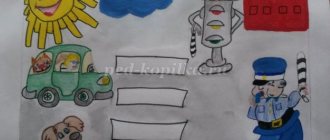Middle group. Junior preschool age. Children 4 - 5 years old
Summary of an open lesson on artistic creativity in the middle group based on the work of K. Chukovsky “Confusion” Summary of an open lesson on artistic creativity in the middle group based on the work of K. Chukovsky “Confusion”
Form of collective work: frontal is a collective work, which is a combination of individual drawings of children, made taking into account...
Open lesson in mathematics “Skills of forward and backward counting to 10” in the middle group Summary of a lesson in mathematics in the middle group. Goal: to consolidate the skills of counting forward and backward to 10, the ability to navigate on the plane of a sheet of paper, to consolidate knowledge about flat and three-dimensional geometric figures, to select objects similar to three-dimensional geometric shapes. figures...
Thematic lesson “Getting to know” children (5-6 years old)
The teacher reminds the children that we communicate with different people in different ways: “Say hello the way you greet:
-with a friend in kindergarten
-with the teacher
-with a clown in the circus
- with my beloved grandmother
- with someone who was offended
- with someone you are glad to see
Now let’s all say together: “Hello!” and let's applaud each other.
Game "Cooks"
Everyone stands in a circle - this is a saucepan. Now we will prepare the soup (compote, vinaigrette, salad). Everyone comes up with what it will be (meat, potatoes, carrots, onions, cabbage, parsley, salt, etc. The teacher hands out pictures.
The teacher shouts out in turn what he wants to put in the pan. The one who recognizes himself jumps into the circle, the next one, jumping, takes the hands of the previous one. Until all the “components” are in the circle, the game continues. The result is a tasty, beautiful dish.
Collective work “Flower meadow of FRIENDSHIP”
A blank clearing hangs on the board. Flower preparations are laid out nearby.
Teacher:
- Guys, will you help Umnyasha and me plant beautiful flowers in the clearing of FRIENDSHIP? Look what flowers we have?
Ushastik:
- Choose the one you like best. Let's take turns. Dasha, take a flower, glue it and draw a stem for it, please. This is the flower Dasha planted! Who, Dasha, will you give the felt-tip pen to? (children take turns gluing flowers)
Psychologist:
- Amazing! We have a very beautiful clearing of FRIENDSHIP!
Game “Blow up, bubble!”
Teacher:
— Guys, do you want to know Umnyasha’s favorite pastime? He will tell you in your ear (Umnyasha speaks into the first child’s ear, and then the children in a circle repeat his words into each other’s ears).
And then we will all say in unison what kind of activity this is
(“Blowing soap bubbles”).
-Come on, let’s also blow soap bubbles (the teacher blows soap bubbles, the children catch them).
Game "Ha-ha-ha! He-he-he!"
Children stand in a circle, clasp their hands. The presenter shows the following:
-Touches left shoulder 3 times, saying “ha-ha-ha”
-Touches the right shoulder 3 times, saying “ho-ho-ho”
-Touches left knee 3 times, saying “hee hee hee”
-Touches the right knee 3 times, saying “he-he-he”
Then all movements are repeated at a faster pace 2 times. Then even faster, 1 time at a time. Then the number of times increases and the pace decreases. By saying the last “heh,” children are invited to throw out all the fatigue, all the anger, all the resentment that has accumulated in their body.
Teacher:
It’s time to say goodbye, but now we will have such a ritual (tradition) that before we go home, we first stand in a circle, stretch out our left hand “from the heart, from the soul” (it turns out to be a pyramid of palms) and say the traditional words: “ One, two, three, four, five – we’ll meet again soon!”
Open classes. Notes - Notes of an open lesson for Mother's Day in the middle group
Publication “Summary of an open lesson for Mother’s Day in the middle school...” Synopsis of the educational activity in the middle group on the topic: “Mother’s Day” Lesson progress: Vera: Hello guys! To understand who we are going to talk about today, guess the riddle: Who came to me in the morning? Who said: “It’s time to get up? “Who managed to cook the porridge? Should I pour some tea into my mug? Who braids me...
Summary of an open lesson on speech development for the middle group “Gifts of Autumn” Types of activities: gaming, motor, communicative, cognitive and research. Goal: Expand children's understanding of the variety of vegetables and fruits. Learn to recognize vegetables and fruits by their characteristic features and name them correctly. Objectives: consolidate general concepts...
Summary of an open lesson on speech development in the middle group “Golden Autumn” Open lesson. Speech development. Theme: “Golden Autumn.” The teacher greets the children: Let’s stand side by side in a circle, Say “Hello” to each other. We are not too lazy to say hello: “Hello” and “Good afternoon” to everyone! If everyone smiles, a good morning will begin! Educator: Guys...
"Winter fun" Summary of an open lesson in the middle group using the "blotography" technique. Summary of an open lesson on artistic and aesthetic development in the non-traditional drawing technique "blotography" (middle group) "WINTER PATTERNS" Topic: "Winter patterns." Purpose of the lesson: To evoke positive emotions in children using artistic expression, music, folklore….
Preschooler's first lesson
First lesson with preschoolers
Imagine this picture...
⠀
The kids went to dance class for the first time. They stand, shifting from foot to foot, looking at each other warily, every now and then looking for their mother. Suddenly one of them begins to sob: loudly, with feeling, from the heart.
⠀ Do you know what will happen next?
⠀Right away, as in a choir that has been well-coordinated over the years, the rest will join in!
⠀Oh...
This situation can be corrected and prevented. To do this, you need to switch it very quickly, but at the same time gently, calmly, so that the child understands: this stranger is friendly towards him.
The game “What’s Where” will help us with this!
You say: “Guys, it’s so great that you came to our class! Do you like it here?
In any case, someone will start communicating with you. You must observe who reacts how, who has what signs of intelligence, who is closed and compressed, who is expanded. You scan children.
Then say: “But we have so many interesting things in our class, you see in that far corner I have prepared something interesting for you. And you know what? Let's go have a look!"
You go there with them and read the state of the children at that moment. Maybe phlegm will come to you, or maybe, on the contrary, nimble children. Your job is to balance this wisely. Focus babies or stir them up.
Then you say: “You and I will play train today. This will be our “Miagkaya” station. And over there we have the machines, the “High Gate” station! We will go in and out from under them. And there in the other corner we have jump ropes!..” You take your cue from what you have in the room.
For the first lesson, 2 stations are enough, maximum 3, regardless of age.
At each station you show what to do. For example, at the “Miagkaya” station you need to fall on the pillows, at the “Vysokiye Vorota” station we drive under the machine and drive out from under it, at the “Skaping Rope” station we wrap the jump rope around our hand and untwist it.
When you have already switched them a little, you need to repeat everything several times, for this age this is very important. Children will feel competent and will already be able to do some simple actions.
Then say: “Guys, we are making a little train, we stand behind each other and take on each other. And we take each other like a piece of cake: tightly and affectionately.” And we show that we put our hands on our shoulders and stretch out our arms. We are trying to make the train perfect. We made a little train, whatever it turned out to be, and off we went. There may be several trains at once, this is normal.
You stopped at a station, for example, “Myagkaya”. Here you fall apart and do the agreed upon action. Then you give them a command with some kind of sound, for example, clap, and the guys assemble the train again.
There should be playful moments to show that you are a cheerful, friendly teacher, that it is interesting and exciting to work with you. Then, even if the children were on the verge of tears, they were alarmed, they would immediately switch.
I recommend games like these, when you redirect the attention of children, to start the lesson. Switching toys are important in the first month; this could be repetition, it could be changing stations, or it could be a completely new game.
It is important to give bright emotions in class!
You can imagine that your frame is a coloring book, but how you color it depends on your emotions. Not only you, but also the children should be emotional. Children should be included in this process, and the more they are involved, the more successfully you can organize the learning process for children.
⠀
Fooling around with preschoolers is a learning process.
What have I done for myself?
The application of the Montessori method begins not with the child, but with the parents. To understand how to develop a child at 4.5 years old and create a favorable environment at home, you first need to work on yourself. Because a parent who is not a resource is not capable of much.
Previously, every free 5 minutes I was distracted by chats that had nothing to do with my development. Now the realization has come that this is an empty exercise that takes a lot of time. But it can be spent usefully: loading the dishwasher and washing machine, clearing the table, hanging laundry, vacuuming, watching children, writing down your thoughts.
If the children see me just sitting and drinking tea, they will drop what they are doing and come running. The same thing will happen if I lie down. Therefore, it is wisest to devote time to the home, and at the same time involve the children. It's no more difficult than chatting, but it's so useful.
Here are a few other small achievements that have significantly improved the quality of my life:
- During the course, I became acquainted with the graph of emotions and each of them separately. Now I can control myself better; this is a valuable skill when communicating with children.
- I learned to find time for myself. At least once a week, my husband and I go out on business or for a walk, and leave the children with their grandmother - they are already old enough. After three such weeks, I learned to concentrate on myself and get proper rest.
- I communicate with Montessori mothers in the alumni chat. We discuss what new things we have learned, what books we have read - and so we develop together. This is my point of interest and source of inspiration.
I learned the habit of not cleaning when the children are asleep immediately after the birth of my daughter. At such moments I sleep, watch webinars, films. I start “my” time with a cup of coffee, something tasty and a languid look out the window.
I want the children to see their mother happy and beautiful. The hardest thing was to realize that I was the main part of the developing environment for children. I created conditions under which it became easier for children to develop and explore the world, but I forgot about myself: this applied to both internal and external resources. Even my husband began to be indignant that I spend the money he gives me on children. I began to change and allow myself what I had denied for a long time. Whether it's cakes, a new shampoo, a trip to a beauty salon or cafe, a walk.
Dating games for preschoolers (from work experience)
Natalya Plakhteeva
Dating games for preschoolers (from work experience)
What are dating games? This is a type of play activity that is aimed at creating a favorable environment in a group of children who do not yet know each other.
The purpose of the games: to help children get to know each other and eliminate inhibitions in communication, to promote the establishment of trusting contact with children, and to unite the group.
Tasks:
- create an atmosphere conducive to communication between children;
- relieve tension, stiffness;
- develop skills of positive social behavior, set them up for friendly communication.
Dating games for preschool children should be short, cyclical and dynamic. Preschool children are characterized by a visual-effective type of thinking. Therefore, when conducting dating games for children of this age, it is necessary to use visual material - toys, pictures. It is desirable that this visual material be bright, original, preferably made with your own hands.
Dating game “I give you a toy.”
This is a great dating game for kids. The teacher shows the toy and says loudly and clearly: “I’m giving the bunny to Olya!” The attention of 2-3 year old children will definitely be attracted by the named toy (a rag toy “Bunny on a finger”, and along with the name of the toy, they will also remember the names of new friends. When the children remember each other’s names a little, you can offer the role of the leader to one of them.
The teacher corrects the child if he incorrectly says the name of the peer he is giving the toy to.
Dating game “Magic Ball”
Children sit in a circle. The teacher passes a ball of thread in a circle to the child sitting next to him, he winds the thread on his finger and at the same time says his name and then passes the ball to the next child. He also says his name, winds the thread around his finger and passes the ball to the next one. And so on until the ball is in the hands of the teacher
Dating game “Multi-colored ball”
The teacher holds a ball in his hands (I made the ball using the Patchwork technique) and says:
"Multi-colored ball
Jumps along the path
Along the path, along the path,
From birch to aspen,
From the aspen-turn,
He’s coming straight to (Mashenka)!”
With the last words, the teacher passes the ball to the child. The child whose name was named takes the ball. Then the child is asked to say his name and the name of the teacher.
Dating game “Box with a surprise”
To organize the game, I took a box that is shaped like a cube.
This game resembles a game with a ball, only at the end the teacher opens the box himself (or gives the child the opportunity to pull the ribbon). From a secret pocket, the teacher takes out and gives small souvenirs to the children as a keepsake of their acquaintance.
One of the tasks of parents and teachers is to teach children to get acquainted, help them establish contacts with peers and make friends with the children of the group.
To help children not be afraid of new acquaintances, to instill in them a desire to make new friends, and children's games for acquaintance are called upon



